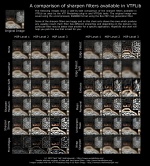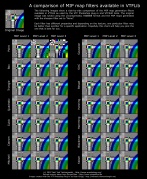How to Upload Own Textures to Csgo Sdk
![]()
![]()
![]()
![]()
![]()
Contents
- i Creating a texture
- 1.1 Converting the texture
- one.ane.i General settings
- 1.1.2 Mipmap settings
- 1.i.3 Normal map settings
- i.two Configuring and saving
- 1.1 Converting the texture
- two Creating a material
- ii.1 Syntax
- 2.2 Parameters
- 3 Run into also
This tutorial is a step-by-pace guide to creating a brand new material, including the creation of the cloth's texture.
Creating a texture
Whatever image file can be used as a texture, so long as both of its dimensions (height and width) are a ability of 2: 2, four, 8, 16, 32, 64, 128, 256, 512, 1024, 2048 and so on. To decide which to use, examine existing textures that make full the same role as yours. Higher resolutions lower operation only make an image sharper when viewed up close.
Different classes of object have dissimilar standard resolutions (e.grand. character models' are very high). Cheque Valve's choices in source materials.gcf with GCFScape if you are always confused.
![]() Note: Texture source files should be saved in a lossless format like TGA pre-compile, to prevent unnecessary loss in quality.
Note: Texture source files should be saved in a lossless format like TGA pre-compile, to prevent unnecessary loss in quality.
![]() Annotation: The file size limit is 33,554,432 bytes. Compiling a .vtf over this amount will cause errors.
Annotation: The file size limit is 33,554,432 bytes. Compiling a .vtf over this amount will cause errors.
Converting the texture
Textures must exist converted to the Valve Texture Format before Source can use them. The tool Valve provides for this is VTEX. It's a command line tool with quite a few limitations, so the third-party tool VTFEdit is preferable: it provides a graphical user interface, allows you to alter a texture's properties without re-compiling it from scratch, accepts a broad range of image formats, and doesn't require the creation of script files for each and every texture. At that place are a scattering of situations where you'll need to fall back on VTEX...but only a handful. Also, if you lot have textures that apply transparency, it is recommended that y'all relieve them in TIFF format before importing to VTFedit every bit PNG transparency tends to have problems.
(There are VTF plug-ins that let you save to the format directly from Photoshop, GIMP and Paint.Internet, but this tutorial volition non comprehend them as non everyone uses those tools.)
To import your texture with VTFEdit, apply File > Import or printing Ctrl+I. Select your epitome and you volition be presented with the import screen:

Full general settings
These settings are the near of import. There are 3:
- Normal format
- The color/compression format that should be used if the texture is opaque.
- Alpha format
- The color/compression format that should exist used if the texture has an alpha aqueduct.
- Texture type
- If you lot imported more than than one image, this determines what they will be used as (animation frames/cubemap faces/depth slices).
If you're making a plain and elementary world texture you won't need to change any of these. If you lot're making a texture with fine gradient item still, you'll demand to cull a not-lossy compression mode.
Mipmap settings
Mipmaps are depression-resolution versions of a texture that swap in when a surface is far abroad from the camera. They greatly reduce the corporeality of texture resizing needed, improving both functioning and image quality. Mips are required for texture LOD to piece of work.
![]() Tip: Textures that will announced in the 3D world should have mipmaps. To conserve memory, textures that will only exist used in a 2d interface should non.
Tip: Textures that will announced in the 3D world should have mipmaps. To conserve memory, textures that will only exist used in a 2d interface should non.
The following images demonstrate the various mipmap filters bachelor in VTFEdit:
-

Sharpen filters
-

Mip filters #1
-

Mip filters #two
-

Mip filters #three
-

Mip filters #four
Normal map settings
These (mis-labelled) settings allow yous to automatically generate a bump map from your input image. Yous'll want to practise this properly with an epitome editor for the material you transport, just the automated option is there if you lot want quick results or a base to work from.
Configuring and saving
When yous hit OK the input file is converted (at that place may be quite a lengthy pause for large images) and the output VTF appears. Now all that is left is configuring the texture with the options in the checkbox list on the left-paw side of the screen. Run into Valve Texture Format#Image_flags for descriptions of each.
Finally, relieve the file somewhere under your game or mod'due south \materials folder.
Creating a material
Source doesn't access textures directly. Everything goes through a material.
Materials are script files that can be created in any text editor, but it's recommended that you utilise Notepad++ in conjunction with the community-made syntax highlighting rules. For your material to be detected, you must save it under your game or mod'due south \materials folder with the extension .vmt .
![]() Note: If you are creating materials and textures exclusively for a map for an existing mod, consider using BSPZIP\Packbsp\Pakrat\Compile Pal to package the material and texture files within the map file itself. This will avert them always becoming lost.
Note: If you are creating materials and textures exclusively for a map for an existing mod, consider using BSPZIP\Packbsp\Pakrat\Compile Pal to package the material and texture files within the map file itself. This will avert them always becoming lost.
Syntax
A material file looks similar this:
<shader> { <parameter> <value> ... } LightmappedGeneric { $basetexture declension\shingle_01 $surfaceprop gravel } There are many shaders to choose from, but about materials will use either LightmappedGeneric (brushes) or VertexLitGeneric (models). The third almost common shader is UnlitGeneric, which is used for UI materials and the occasional tool texture.
Parameters
- For a list of all documented shader parameters, see Category:List of Shader Parameters.
With a shader chosen you're onto parameters (also called commands). There are hundreds of options for what to put in a material so this article will simply cover the most mutual, which are accustomed past more than or less all shaders. They are:
-
$basetexture -
$surfaceprop -
$envmap -
$bumpmap -
$detail -
$selfillum -
$model
![]() Tip: If yous e'er need to utilise a space or tab character in a parameter value, you must wrap the whole value with "quote marks". You'll often see absolutely everything wrapped like this - save yourself some typing, every bit that's unnecessary.
Tip: If yous e'er need to utilise a space or tab character in a parameter value, you must wrap the whole value with "quote marks". You'll often see absolutely everything wrapped like this - save yourself some typing, every bit that's unnecessary.
For instance: Volition reload every single fabric in the filesystem named "combine_barricade_short01a", including all the custom content. For example: both "materials/models/props_combine/combine_barricade_short01a.vmt" and "materials/models/props_metal_barricade/combine_barricade_short01a.vmt" will be reloaded. This may appear very useful when writing proxies. ![]() Tip: To refresh a material in-game without restarting it, apply the following console control: mat_reloadmaterial "vmt_name without .vmt and quotation marks". Even though "mat_reloadallmaterials" control exists information technology's not recommended to employ information technology since various artifacts may appear. mat_reloadtextures is presented too, but seems to be very buggy.
Tip: To refresh a material in-game without restarting it, apply the following console control: mat_reloadmaterial "vmt_name without .vmt and quotation marks". Even though "mat_reloadallmaterials" control exists information technology's not recommended to employ information technology since various artifacts may appear. mat_reloadtextures is presented too, but seems to be very buggy. mat_reloadmaterial combine_barricade_short01a
Meet likewise
- Cloth
- Textile Editor
- Creating Reflective Materials
- Adapting PBR Textures to Source
- Category:List of Shader Parameters
Source: https://developer.valvesoftware.com/wiki/Creating_a_Material
Post a Comment for "How to Upload Own Textures to Csgo Sdk"